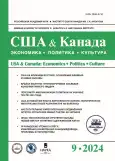U.S. vs. Russia: Cyber «Drang nach Osten»
- Autores: Selyanin Y.V.1
-
Afiliações:
- Institute of World Economy and International Relations, Russian Academy of Sciences.
- Edição: Nº 9 (2024)
- Páginas: 62-77
- Seção: U.S. and the World
- URL: https://journals.rcsi.science/2686-6730/article/view/264038
- DOI: https://doi.org/10.31857/S2686673024090058
- EDN: https://elibrary.ru/ZVMYUS
- ID: 264038
Citar
Texto integral
Resumo
Sobre autores
Yaroslav Selyanin
Institute of World Economy and International Relations, Russian Academy of Sciences.
Email: yaroslav.selyanin@yandex.ru
ORCID ID: 0000-0002-3802-0563
Research Fellow, Center for North American Studies Moscow, Russian Federation
Bibliografia
- Martin, A. U.S. military hackers conducting offensive operations in support of Ukraine, says head of Cyber Command. Sky News. 2022. June 01. Available at: https://news.sky.com/story/us-military-hackers-conducting-offensive-operations-in-support-of-ukraine-says-head-of-cyber-command-12625139 (accessed 25.12.2023).
- Pomerleau, M. Cyber National Mission Force declared sub-unified command. DefenseScoop. 2022. December 19. Available at: https://defensescoop.com/2022/12/19/cyber-national-mission-force-declared-sub-unified-command/ (accessed 19.12.2023).
- Presidential Policy Directive/PPD-20. Federation of American Scientists. 2012. October 16. Available at: https://irp.fas.org/offdocs/ppd/ppd-20.pdf (accessed 10.11.2023) .
- Pomerleau, M. New authorities mean lots of new missions at Cyber Command. C4ISRNET. 2019. May 08. Available at: https://www.c4isrnet.com/dod/cyber-com/2019/05/08/new-authorities-mean-lots-of-new-missions-at-cyber-command/ (accessed 27.10.2023).
- National Security Presidential Memoranda [NSPMs]. Federation of American Scientists. Available at: https://irp.fas.org/ offdocs/nspm/ (accessed 10.11.2023).
- John, S. McCain National Defense Authorization Act for Fiscal Year 2019. GovInfo. 2018. Available at: https://www.govinfo.gov/content/pkg/PLAW-115publ232/pdf/PLAW-115publ232.pdf (accessed 11.11.2023).
- Pomerleau, M. Defense officials taking advantage of new cyber authorities. C4ISRNET. 2018. November 27. Available at: https://www.c4isrnet.com/dod/cyber-com/2018/11/27/defense-officials-taking-advantage-of-new-cyber-authorities/ (accessed 27.10.2023).
- CYBER 101: Hunt Forward Operations. U.S. Cyber Command. 2022. November 15. Available at: https://www.cybercom.mil/Media/News/Article/3218642/cyber-101-hunt-forward-operations/ (accessed 27.10.2023).
- "Building Resilience": U.S. returns from second defensive Hunt Operation in Lithuania. U.S. Cyber Command. 2023. September 12. Available at: https://www.cyber-com.mil/Media/News/Article/3522801/building-resilience-us-returns-from-second-defensive-hunt-operation-in-lithuania/ (accessed 27.10.2023).
- Kass, D.H. U.S. Cyber Command Year in Review 2022 Shows Major Steps to Defend Nation from Cyber Adversaries. MSSP Alert. 2023. January 06. Available at: https: / / www.msspalert.com/ news / u-s-cyber-command-year-in-review-2022-shows-major-steps-to-defend-nation-from-cyber-adversaries (accessed 27.10.2023).
- Pomerleau, M. Army's tactical cyber and electronic warfare unit gets new commander. DefenseScoop. 2023. June 30. Available at: https://de-fensescoop.com/2023/06/30/armys-tactical-cyber-and-electronic-warfare-unit-gets-new-commander/ (accessed 27.10.2023).
- Before the Invasion: Hunt Forward Operations in Ukraine. U.S. Cyber Command. 2022. November 28. Available at: https://www.cybercom.mil/Media/News/Arti-cle/3229136/before-the-invasion-hunt-forward-operations-in-ukraine/ (accessed 27.10.2023) .
- Ответ специального представителя Президента Российской Федерации по вопросам международного сотрудничества в области информационной безопасности, директора Департамента международной информационной безопасности МИД России А.В. Крутских на вопрос газеты «Коммерсант». Министерство иностранных дел Российской Федерации. 2022. 6 июня. Available at: https://www.mid.ru/ru/foreign_policy/news/1816353/ (accessed 30.10.2023).
- National Cybersecurity Strategy 2023. The White House. 2023. March 1. Available at: https://www.whitehouse.gov/wp-content/uploads/2023/03/National-Cyberse-curity-Strategy-2023.pdf (accessed 26.12.2023).
- Pomerleau, M. Russia-Ukraine conflict forces DOD to revise assumptions about cyber's impact in war. DefenseScoop. 2023. September 18. Available at: https://de-fensescoop.com/2023/09/18/russia-ukraine-conflict-forces-dod-to-revise-assump-tions-about-cybers-impact-in-war/ (accessed 25.12.2023).
- Vasquez, C Mayorkas warns Latin American leaders of Beijing's technology influence. CyberScoop. 2023. September 28. Available at: https://cyberscoop.com/mayor-kas-latin-america-china/ (accessed 30.10.2023).
- Гладков, А. Твой телефон ключ доступа к тебе. Про российские мобильные ОС @MobileDeveloper. Канал Максима Горшенина на YouTube. 2023. May 06. Available at: https://www.youtube.com/watch?v=DwZGInVBKvU (accessed 10.11.2023).
- Pomerleau, M. New triad is evolving deterrence for joint force. DefenseScoop. 2023. October 11. Available at: https://defensescoop.com/2023/10/11/new-triad-is-evolving-deterrence-for-joint-force/ (accessed 30.10.2023).
- Martin, A. Ukraine war: US cyber chief on Kyiv's advantage over Russia. Sky News. 2022. June 8. Available at: https://news.sky.com/story/ukraine-war-us-cyber-chief-on-kyivs-advantage-over-russia-12628869 (accessed 25.12.2023).
- US Leadership in Tech Diplomacy: A Conversation with Ambassador Nathaniel C. Fick. Hudson Institute. 2023. June 21. Available at: https://www.hud-son.org/events/us-leadership-tech-diplomacy-conversation-ambassador-nathaniel-c-fick (accessed 02.11.2023).
- Bing, C. Command and control: A fight for the future of government hacking. CyberScoop. 2018. April 11. Available at: https://cyberscoop.com/us-cyber-command-nsa-government-hacking-operations-fight/ (accessed 03.11.2023).
- Chesney, R. Title 10 and Title 50 Issues When Computer Network Operations Impact Third Countries. The Lawfare Institute. 2018. April 12. Available at: https://www.lawfaremedia.org/article/title-10-and-title-50-issues-when-computer-network-operations-impact-third-countries (accessed 02.11.2023).
- Lonergan, E.D. Cyberspace Is Neither Just an Intelligence Contest, nor a Domain of Military Conflict; SolarWinds Shows Us Why It's Both. The Lawfare Institute. 2021. May 12. Available at: https://www.lawfaremedia.org/ article/cyberspace-neither-just-intelligence-contest-nor-domain-military-conflict-solarwinds-shows-us-why (accessed 02.11.2023).
- Borghard, E.D., Lonergan, S.W. U.S. Cyber Command's Malware Inoculation: Linking Offense and Defense in Cyberspace. Council on Foreign Relations. 2020. April 22. Available at: https://www.cfr.org/blog/us-cyber-commands-malware-inoculation-linking-offense-and-defense-cyberspace (accessed 02.11.2023).
- Elgan, M. What cybersecurity teams can learn from the US Cyber Command's «hunt forward». SecurityIntelligence. 2022. July 15. Available at: https://securityintelli-gence.com/ articles/what-cybersecurity-teams-learn-us-cyber-command-hunt-for-ward/ (accessed 02.11.2023).
- Final Report of the Defense Science Board (DSB) Task Force on Cyber Deterrence. Federation of American Scientists. 2017. February. Available at: https://irp.fas.org/ agency/dod/dsb/cyber-deter.pdf (accessed 16.11.2023).
- Vicic, J., Winger, G.H. What the Defense Department's Cyber Strategy Says About Cyber Conflict. The Lawfare Institute. 2023. October 19. Available at: https: / / www.lawfaremedia.org/article/what-the-defense-department-s-cyber-strat-egy-says-about-cyber-conflict (accessed 03.11.2023).
- Weber, V. The Benefits and Risks of Extending Weapons Deliveries to the Cyber Domain. The Lawfare Institute. 2022. December 02. Available at: https://www.lawfare-media.org/article/benefits-and-risks-extending-weapons-deliveries-cyber-domain (accessed 03.11.2023).
- Lostri, E. What Will Mechanisms for Cybersecurity Aid Look Like? The Lawfare Institute. 2023. September 12. Available at: https://www.lawfaremedia.org/arti-cle/what-will-mechanisms-for-cybersecurity-aid-look-like (accessed 03.11.2023).
- В Минобороны рассказали о работе США над патогенами в Средней Азии и Закавказье. Лента.ру. 2023. 10 марта. Available at: https://lenta.ru/news/2023/03/10/usa_labs/ (accessed 25.12.2023).
- DOD Cyber Strategy Summary. U.S. Department of Defense. 2023. September 12. Available at: https://media.defense.gov/2023/Sep/12/2003299076/-1/-1/1/2023_DOD_Cyber_Strategy_Summary.PDF (accessed 26.12.2023).
Arquivos suplementares








